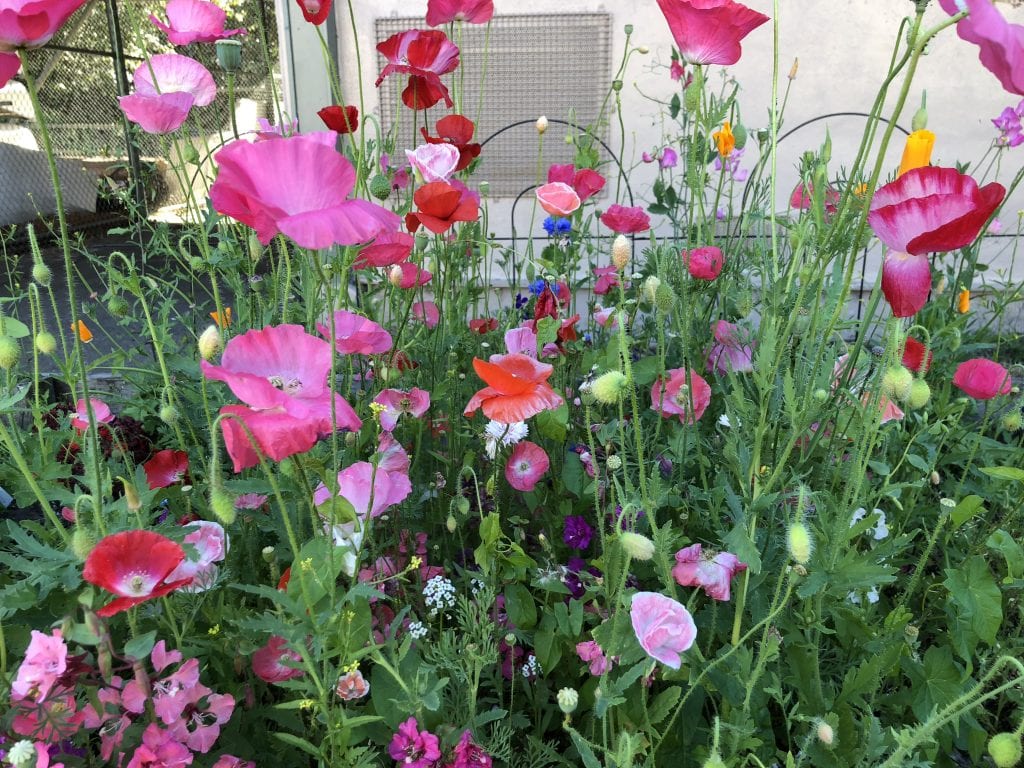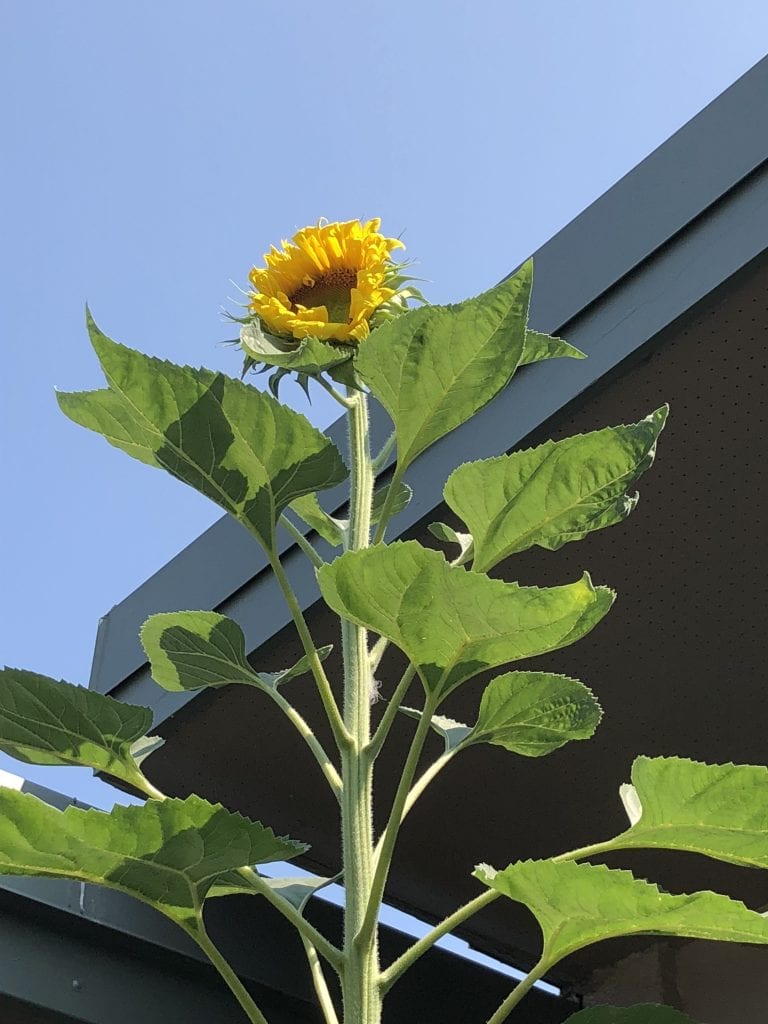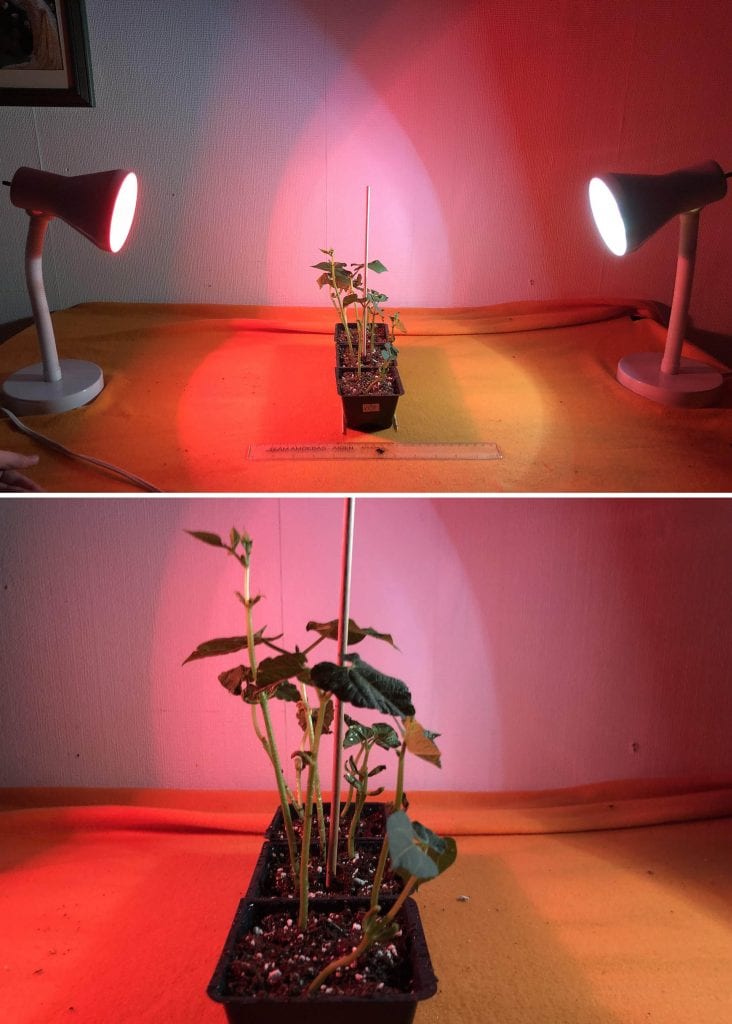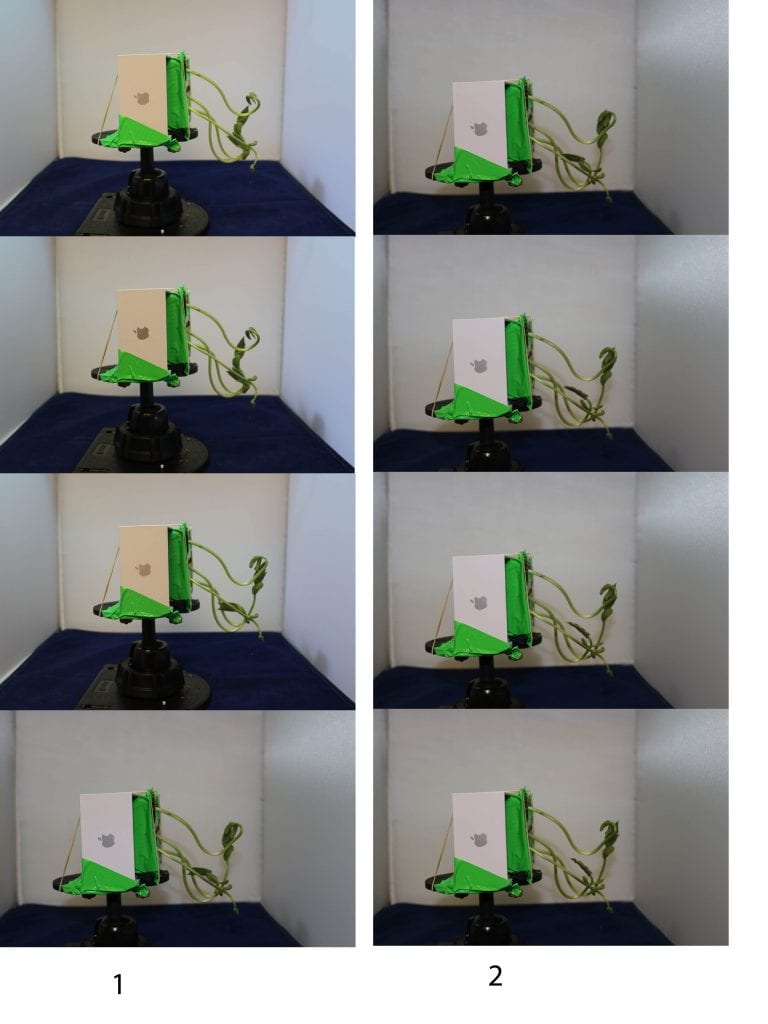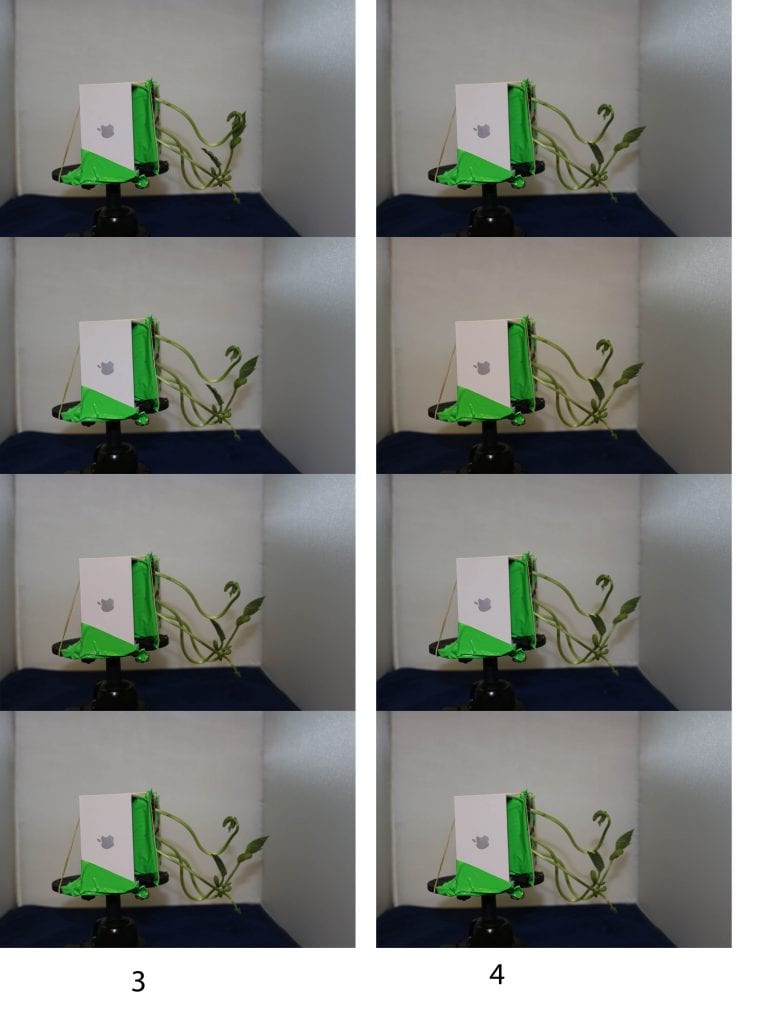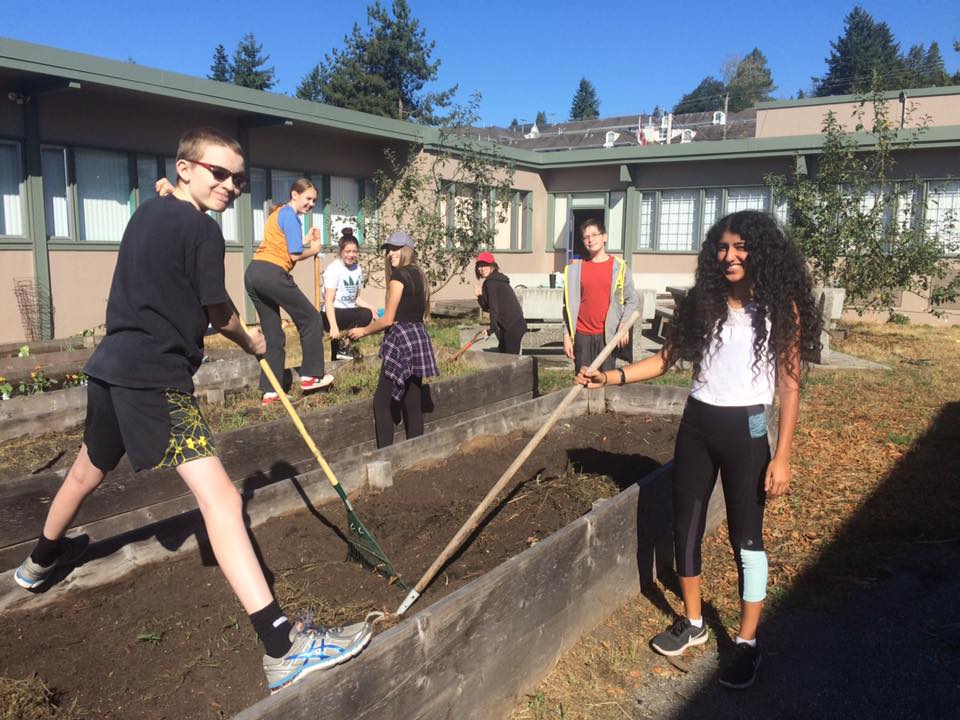Plant Biology IDS – Studying plants from seed to fruit and applying that knowledge
By Aiden Cumming-Teicher
My grade 10 IDS was composed of three parts:
PART 1. Growing a garden
Inquiry Hub had an existing garden that had fallen into disrepair, as there was no one taking care of it anymore. The infrastructure ( planters and dirt, access to water) was there, so I decided to revive it. I started a Garden Club and with occasional help from some of the other people that joined it was able to get it going. I made the decision early on to not apply for grants for this year or change anything, but to run the garden as a baseline year to see the state of the planters, soil, etc.
In a nutshell, running the garden entailed
Fall/Winter:
- researching seeds to plant, ph and soil, companion planting, different seeds/ plants and their benefits for attracting pollinators, how to grow seeds indoors and which to direct sow in the spring
- Made an inventory of seeds for the garden and growing supplies, and cleared the garden to get it ready for planting.
- Figure out a budget and where the money is better spent
- Created a diorama to better plan companion planting and show ultimate garden plan
- planted flower bulbs for winter/ early spring colour.
- sought out advice from my mentor (Dave Carswell) about winterizing the garden, and companion planting from Ms. Lindsay Fraser ( who runs the garden at Science World), pruning from Mr. Mike at Amsterdam Greenhouses on Fruit Tree pruning and pest control ( for ants)
- Regularly wrote blogs on the school blog to follow progress: https://green.inquiryhub.org/20172018-3ailis/
- Regularly taking ph and temperature measurements for my data collection, every 2 weeks
- Ongoing weeding and planter maintenance
Spring
- In March I started growing seeds indoors so that I could transplant them after spring break and built trellises to support different plants
- Continued garden weeding and maintenance and researched tree pruning
- Grew seedlings indoors into healthy plants and transplanted them into the garden planted
- Seeded planters with wildflowers and sunflowers
- Watered and cared for garden plants
- Rescued broken apple branches and turned the apples into applesauce, then applesauce bread to share with the school
Summer
- watered and care for plants until they flowered and/or produced vegetables
- Tending and watering the plants, especially the vegetables, was crucial during the summer months.
Challenges and Observations:
- The garden is definitely due for a revamp. Several of the planters have boards that fell apart, allowing for less water retention for the plants and more ant infestations. New planters would definitely help!
- In addition, the soil quality is poor after several years of use. The plants produced vegetables but were small and frail ( and had less yield) than the same plants I planted in our home garden, which has better soil. Some soil remediation ( manure for example), or new soil entirely would really benefit future harvests. Or, if that’s not possible the flowers and wildflowers really thrived; the soil is just fine if the garden is only a flower garden instead of a vegetable one.
- I secured a key and brought a garden hose to be able to water the garden during the summer while the school is closed. For the garden to thrive there really needs to be consistent watering, so more people need to be able to help so it’s not just one person doing the watering all the time. Especially with heat/ drought during the summer, it can be really hard to make sure they are getting enough water.
- The existing apple trees were outside of my project and I was instructed to leave them be, but I would suggest if they are to survive it would be great to have an arborist come to look at them and provide advice. The apples they produced were delicious.
Documentation:
Visual diary of plant growth, temperature and pH charts, time tracking sheet
PART 2. Plant Biology and Behavior
Purpose: I wanted to conduct some practical experiments with seeds (and seedlings) to find out the optimal combination using gravitropism and phototropism to create the ideal environment for growing plants in space.
Courses :
- Over the winter break, I completed a course on Coursera (Understanding Plants – Part I: What a Plant Knows from the University of Tel Aviv) to understand more about how plants sense and react to different stimuli: https://www.coursera.org/learn/plantknows/home/info
- I also studied the Khan Academy unit on AP Bio-Plant Biology
Experimental/Practical Research
Once I finished those courses and had a good understanding of plant response to stimuli I went onto the experimental part of my project, biology/ botany experiments using some of the plants I had been growing from seed. I wanted to answer the following
1. Do roots always grow down or can this be manipulated ( Gravitropism)
2. Rates of growth depending on the color light (Phototropism).
Experiments:
PLANTS & SPACE TRAVEL: MANIPULATING GRAVITROPISM & PHOTOTROPISM
ABSTRACT
When humans travel through the stars, we will need one fundamental skill. The ability to grow food within the constraints of space. Botany will become an essential science for space travel. This research for the purpose of growing plants in space will be a difficult task to undertake, as space travel will have very tight areas for the growth of food. In this project, I have done multiple experiments detailing the effect of Gravitropism and Phototropism.
I want to test and learn more about the effects of Gravitropism and Phototropism, especially regarding the movement of shoots and how they might be manipulated in order for optimal growing conditions in the unique restrictions you may have on a spacecraft. Some of these are limited space, lack of natural light, and zero gravity. I tried to mimic conditions in a couple of different ways. For my Phototropism experiments, I went about this by having only one source of light by conducting it in a basement devoid of outside light. For my Gravitropism experiment, I suspended the plants at different angles, to show how they might move in zero gravity. The way I went about this is through 3 different experiments which tested them in these specific ways:
In the first experiment, I have placed the light subsequently in different places on the table, and watch the plants bend towards it. In regards to the plants, they are under 3 different conditions, with one set having an opaque cap, another having an opaque wrap over the lower half of the stalk, and one control without any conditions. In this experiment I found what I expected, which was that the opaque cap plants (Set A) did not bend, however the others did.
In the second experiment, I researched which colour of light plants respond to the best between red and blue. I chose blue and red because they are the longest and shortest wavelengths respectively. Because blue light helps with growth and red with flowering my theory was that the seedlings would respond more to the blue light & bend towards it. In the end I found that was not the case but they bend equally towards either source of light. Finally in the third experiment, I tested the effects of Gravitropism on the plant. The way I did this is having bean plants suspended perpendicular to the ground using a ball jointed platform. I took pictures of the plants every 20 minutes for 12 hours, and found that indeed they grew upwards.
In conclusion I have found that plant shoots respond positively to light, and negatively to gravity.
EXPERIMENT #1: PHOTOTROPISM AT WORK
In this experiment I will be adapting an experiment done by Darwin and his son Francis in 1880, proving that phototropism will cause a plant to bend towards the light. I will be proving two things in this experiment. Firstly, that plants respond to and bend towards light, and that perception of light in the plant is removed from the site of action.
HYPOTHESIS:
My Hypothesis is that shoots respond positively to light, and thus grow towards it.
MATERIALS:
- Sprouted Bush beans to ~ 3in
- Mini-Greenhouse
- Aluminum foil
- Spray Bottle
- Lamp
METHODOLOGY:
– First, sprout the Bush Beans in a regular Mini-Greenhouse to ~ 3in, on top of soil, and misting with water using a spray bottle
– Second, do a control set (3 seeds) with one light source (Lamp) and no aluminum foil cap in 2 directions, in order to show the effect of phototropism.
– Then do it with one set (3 seeds) having aluminum foil over the coleoptile, and one set (3 seeds) with the aluminum foil around the part of the stem that bends
– Concurrently run all three sets, so that the conditions stay constant
– To control light source completely perform the experiment in dark room w/ only one source of light (Lamp)
– Run experiment 3 times, all in separate directions of light.
– To measure movement, I put a stick at the centre of each set, averaged the height of the bean plants, and then drew a little mark as to where to that would land. After each direction of movement finishes (24 hours), take the distance from this point to each coleoptile, and then average these numbers. You will get a value (Note: if the plant bends slightly away from light (see errors) then attribute a negative value to it. (See fig.1 for more details)
– To infer data, think about this. Positive numbers means a positive reaction, and the opposite means a negative reaction
Conclusion:
In this first experiment, I positioned a bright light in different places, modifying an experiment done by Charles and Francis Darwin in 1880. I had an opaque cap over the first set, inhibiting its ability to see light. In the second set, I had an opaque cover over the stem to demonstrate that sensory of light is physically removed from the site of action. The final set was simply a control set. I chose Bush Beans as they are quick and easy to grow, and in my experience respond very drastically to the movement of light. In the end, I found results to be as expected. The set with the opaque cover did not move very much, as anticipated. However, one source of error could that because of the weight of the aluminum foil, this set did bend to one side, but it did not come back the other way, therefore the average distance moved was minuscule. The other two sets towards the light normally.
Overall, the results of this experiment were correct and anticipated but perhaps skewed by the medium for which I made my opaque covers (Aluminum Foil).
POSSIBLE SOURCES OF ERROR:
In experiment 1, I used aluminum foil as my opaque material. The troubles this caused are as follows:
- Due to the weight of the aluminum foil, the set with the opaque cap leaned to one side. This caused the inability to determine whether it was the lack of light or the weight of the cap causing it not to grow towards the light
- In the bending portion, where I put aluminum foil, it moved a lot of weight there, somewhat restricting bending in the stalk. This problem, however is not as significant, as it still bends, just at a much slower pace
EXPERIMENT #2: RED OR BLUE?
HYPOTHESIS:
My Hypothesis is that shoots respond negatively to gravity, and thus grow away from it.
MATERIALS:
- Sprouted Bush Beans to ~ 3in
- Mini-Greenhouse
- Spray bottle
- 2 lamps
- Blue light bulb
- Red light bulb
METHODOLOGY:
– First, sprout the Bush Beans to ~3 in in a regular Mini-Greenhouse, on top of soil, and misting with water using a spray bottle
– Then set up 2 lamps, one with a blue lightbulb one with red
– Wait for 24 hours then measure from the center the distance to the coleoptile, and the direction it was in. See fig. 3 for more details.
POSSIBLE SOURCES OF ERROR:
-Well, I was wrong with my hypothesis. This could be because of:
- Proximity; The lightbulbs may have been too close to the plants
- Heat; the lightbulbs were very hot, and that could have possibly played
That they did not distinguish between red and blue light
Conclusion:
In this experiment, I placed 2 lights; one red, and one blue. I wanted to see whether or not the plants respond differently to separate colors of light. In the end, the plants responded equally towards both lights, meaning that they bent towards the light they were closest to and not towards a particular colour.
EXPERIMENT #3 – GRAVITROPISM IN BEAN PLANTS
HYPOTHESIS:
My Hypothesis is that shoots respond negatively to gravity, and thus grow away from it.
MATERIALS:
- Sprouted Bush Beans ( about ~3” tall)
- Small Box
- Platform
- Duct Tape
- Rubber Bands
- Camera with timer
- Light Source
METHODOLOGY:
– Take sprouted Bush Beans in soil and secure them
– Then, put it in a small box
– Flip box horizontally & secure to a ball-jointed platform (I used Duct tape and rubber bands)
– Take photo ~20 mins at regular intervals
– Every 6 six hours, rotate box 180O
– Collect data, and create a visual log ( see fig.2)
– Repeat this over 12 hours
POSSIBLE SOURCES OF ERROR:
In experiment 3 there were a couple of problems:
- Originally I used wheat plants, which not really work, as in this stage of their development, they grow straight and do not really bend.
- I also had a light source that was counteractive to the experiment, being perpendicular to the source of gravity
- My camera battery died, and I didn’t notice as I was relying on the timer. I had to get a back up camera and re-start the experiment
Conclusion:
In this final experiment, I was testing the effects of Gravitropism on plants. I did this by suspending the plants from a ball jointed platform so that they could be at a 90-degree angle. The experiment was successful and through a series of timed photos, I was able to document the upward movement of the stem over 6 hours. One very small error was that one of the Bush Beans was not able to upright itself, possibly due to a weak root system. See fig. 3 below
FUTURE WORK AND REAL WORLD APPLICATIONS
Food production is essential for humankind. We have inhospitable environments like space, other planets, terrain with poor soil conditions or places like the north and south pole where its difficult to grow plants normally. We need to understand how plants work and how we can manipulate the stimuli to help them thrive in challenging conditions.
I want to test and learn more about the effects of Gravitropism and Phototropism, especially regarding the movement of shoots and how they might be manipulated in order for optimal growing conditions in the unique restrictions you may have on a spacecraft and for space travel.
Eventually this can help us produce better/ more food both for space exploration and in challenging areas of our own planet.
BIBLIOGRAPHY:
GCSE Bitesize: Sensitivity in plants. (2014, January 01). Retrieved February 04, 2018, from http://www.bbc.co.uk/schools/gcsebitesize/science/aqa/nervesandhormones/controlinplantsrev1.shtml
VanSomeren, L. (2016, May 01). This is how plants “see” the light. Retrieved February 04, 2018, from http://www.untamedscience.com/biology/plants/phototropism/
Dogwood, A., Dr. (2016, August 15). Tropisms. Retrieved February 04, 2018, from http://www.biology-pages.info/T/Tropisms.html
Plant Phototropism Experiment | Science Project. (2013, September 11). Retrieved February 04, 2018, from https://www.education.com/science-fair/article/effect-color-light-phototropism/
Robertson, R. E., Professor Sir. (1996, December 31). 8.2.1 Gravitropism. Retrieved February 04, 2018, from http://plantsinaction.science.uq.edu.au/edition1/?q=content%2F8-2-1-gravitropism
PART 3. – IDS Presentation
I presented my findings at the Science Expo in Coquitlam late in the Spring. Sadly I fell ill and could not stay long to present my research. I would also have liked to have the opportunity to go beyond replicating experiments and focus on 3d Printing a 3d design to replicate conditions of zero gravity, but due to illness was unable to work on that.
Instead, after I recovered I focused on creating a video presentation for the Khan Academy Breakthrough Junior Challenge (https://breakthroughjuniorchallenge.org/enter ). The full video can be watched here:
https://www.youtube.com/watch?v=51HIgCKYGLg&t=26s
IN CONCLUSION
The delicious rewards from the garden were harvested and shared with classmates and teachers at the school- tomatoes, rhubarb, zucchini, apples (turned into apple bread), carrots, corn, kale, cabbage, beans, peas and sunflowers. I enjoyed both the learning and research aspect of plant biology and the actual growing and caring for a school garden. From my plant biology research I would have liked the time to spend on creating a prototype.
Some suggestions I have after this year for the garden to be more successful would be to have a larger group of people take it on and focus on revitalizing it from planters, soil, weeding etc and create a schedule with dedicated volunteers. I enjoyed growing (and eating ) vegetables, but it’s definitely more than a one man job.
